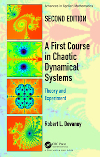- About MAA
- Membership
- MAA Publications
- Periodicals
- Blogs
- MAA Book Series
- MAA Press (an imprint of the AMS)
- MAA Notes
- MAA Reviews
- Mathematical Communication
- Information for Libraries
- Author Resources
- Advertise with MAA
- Meetings
- Competitions
- Programs
- Communities
- MAA Sections
- SIGMAA
- MAA Connect
- Students
- MAA Awards
- Awards Booklets
- Writing Awards
- Teaching Awards
- Service Awards
- Research Awards
- Lecture Awards
- Putnam Competition Individual and Team Winners
- D. E. Shaw Group AMC 8 Awards & Certificates
- Maryam Mirzakhani AMC 10 A Awards & Certificates
- Two Sigma AMC 10 B Awards & Certificates
- Jane Street AMC 12 A Awards & Certificates
- Akamai AMC 12 B Awards & Certificates
- High School Teachers
- News
You are here
A First Course In Chaotic Dynamical Systems: Theory And Experiment

Publisher:
Chapman and Hall/CRC
Publication Date:
2020
Number of Pages:
328
Format:
Hardcover
Edition:
2nd
Price:
99.95
ISBN:
9780367235994
Category:
Textbook
[Reviewed by , on ]
Bill Satzer
07/24/2021
This is the second edition of a book first published twenty-five years ago. The first edition made a considerable impression because it was one of the first texts that effectively brought the ideas of chaos theory to undergraduates with just some calculus. Devaney is author or co-author of several other books on dynamical systems, differential equations, fractals, and chaos, but the current one is the book best suited for students new to the subject. The only prerequisite is a one-year course in calculus, and no background in differential equations is required.
The book begins gently with an introduction to dynamical systems starting with a brief history, some examples and several images of Mandelbrot and Julia sets. The technical discussion begins with the orbits generated by the iteration of one-dimensional maps and the graphical analysis of their dynamics. The important notions of fixed and periodic points come next. With bifurcations, we begin to get to more complicated ideas. It’s here that period-doubling is introduced. Devaney chooses to do this using \( x^{2}+c \) maps instead of the more commonly used logistic function. (This leads eventually in a natural way to the Julia and Mandelbrot sets when extended to the complex plane.) It’s at this point in the development where transition to chaos for the \( x^{2}+c \) maps is introduced, and the Cantor set shows up too. Chaos is not defined yet; so far it just means the transition from tame to more complicated dynamics.
Next there is a big step in abstraction to symbolic dynamics, leading to Sharkovsky’s Theorem (the generalization of ”Period 3 implies Chaos”) and the associated Sharkovsky ordering of the integers. Readers are then introduced to a rigorous definition of chaos. This is a large step up in abstraction, but it is handled so well that it almost seems like the natural path to follow. Devaney ends this part of the book with a treatment of critical points and the Schwarzian derivative. A discussion of iteration as applied in Newton’s method for root finding pulls together many of the previous ideas.
From there it’s on to a fairly extensive treatment of fractals, especially the Mandelbrot and Julia sets. The new edition adds several features. These include an exploration of the Sierpinski carpet, treatments of iterated function systems and the chaos game. The new material also expands to look at iterations of cubic, rational, exponential and trigonometric functions. While the first edition had many computer experiments for students to perform, this edition adds several more.
By now there are many books available that introduce this subject. This one remains one of the most accessible and well-written. Devaney has clearly given a lot of thought to the pacing, sequence of topics, and supporting material. He’s also provided many good exercises.
Bill Satzer (bsatzer@gmail.com), now retired from 3M Company, spent most of his career as a mathematician working in industry on a variety of applications. He did his PhD work in dynamical systems and celestial mechanics.
See the publisher's website.
- Log in to post comments




